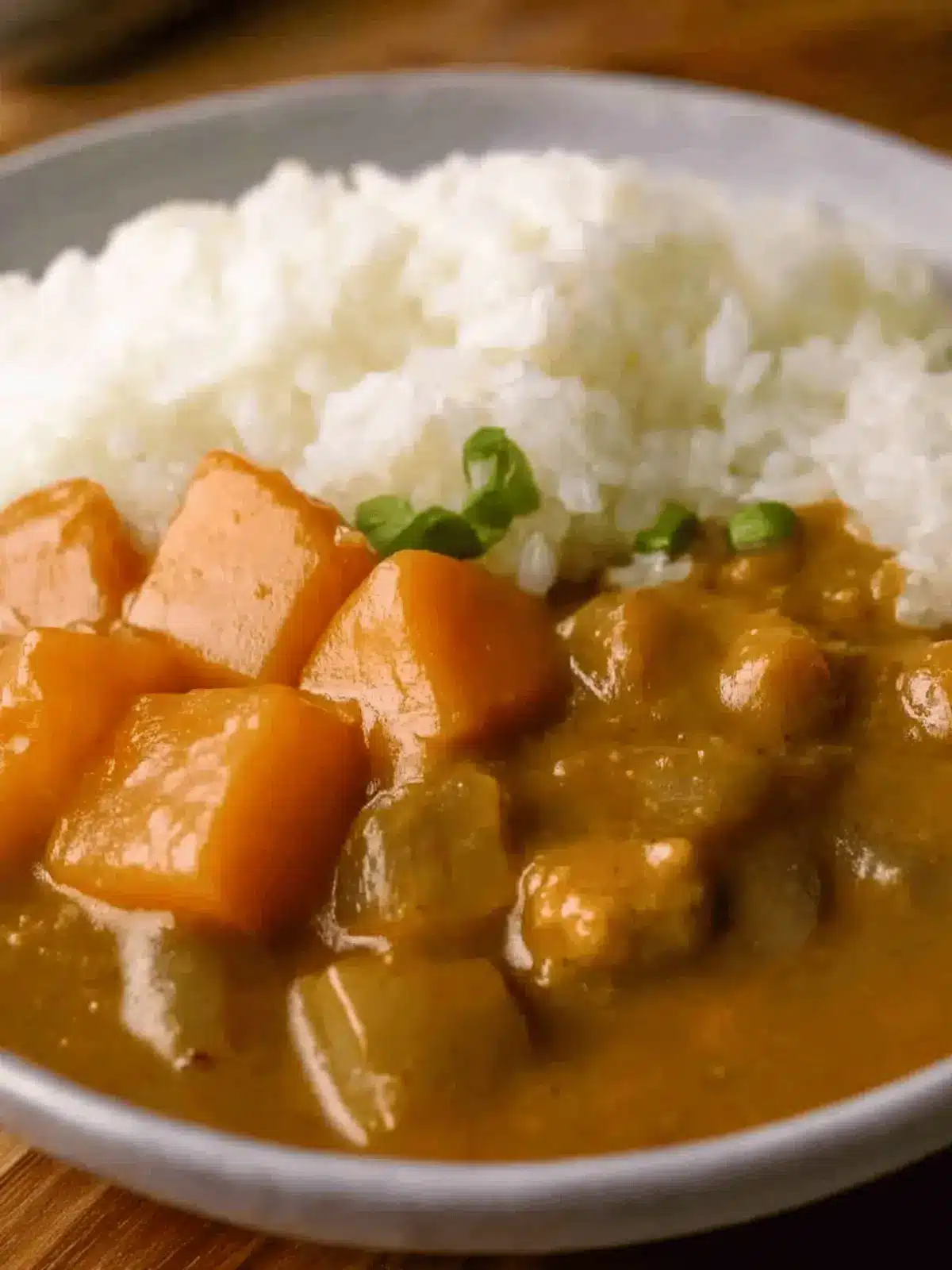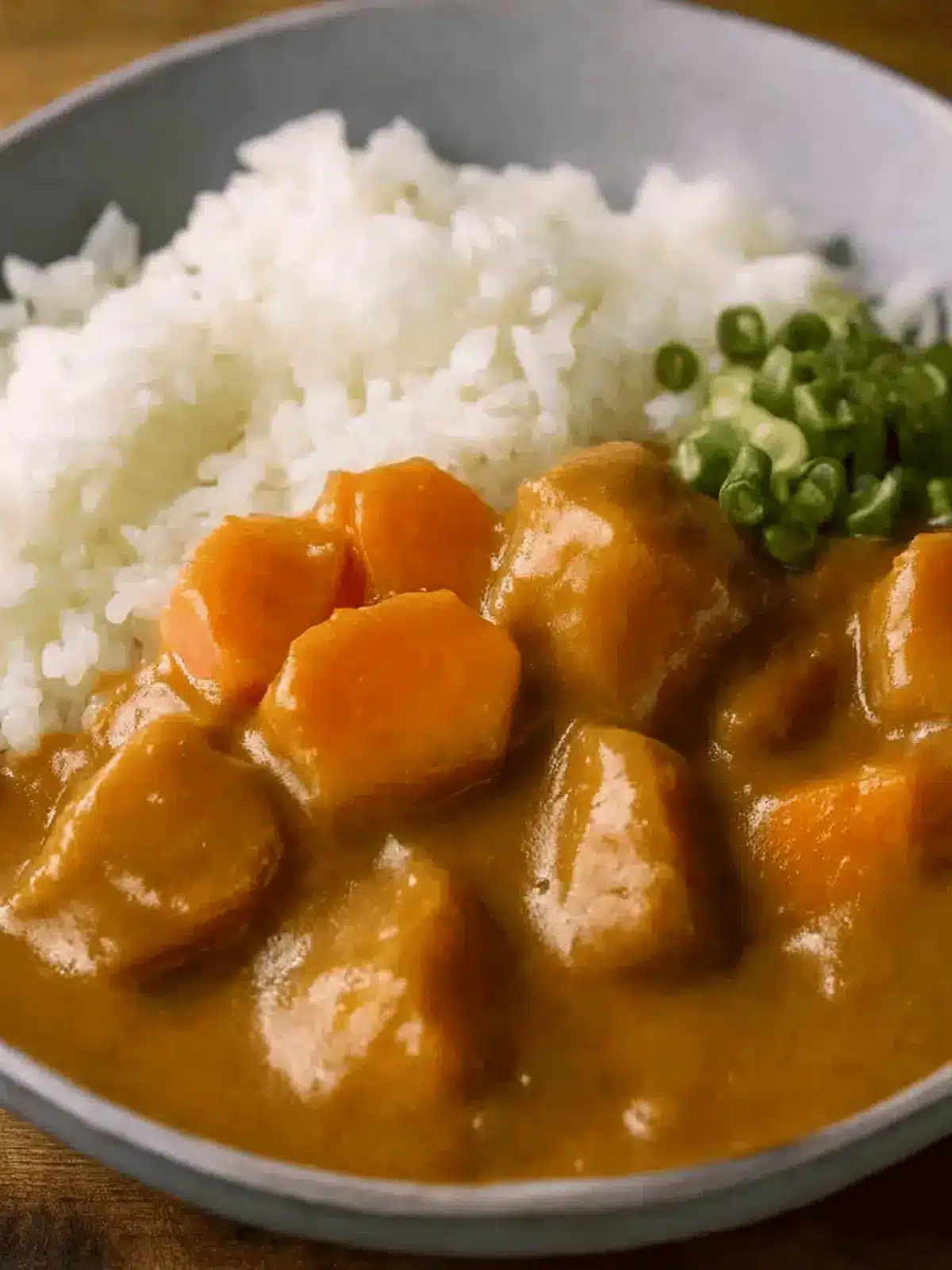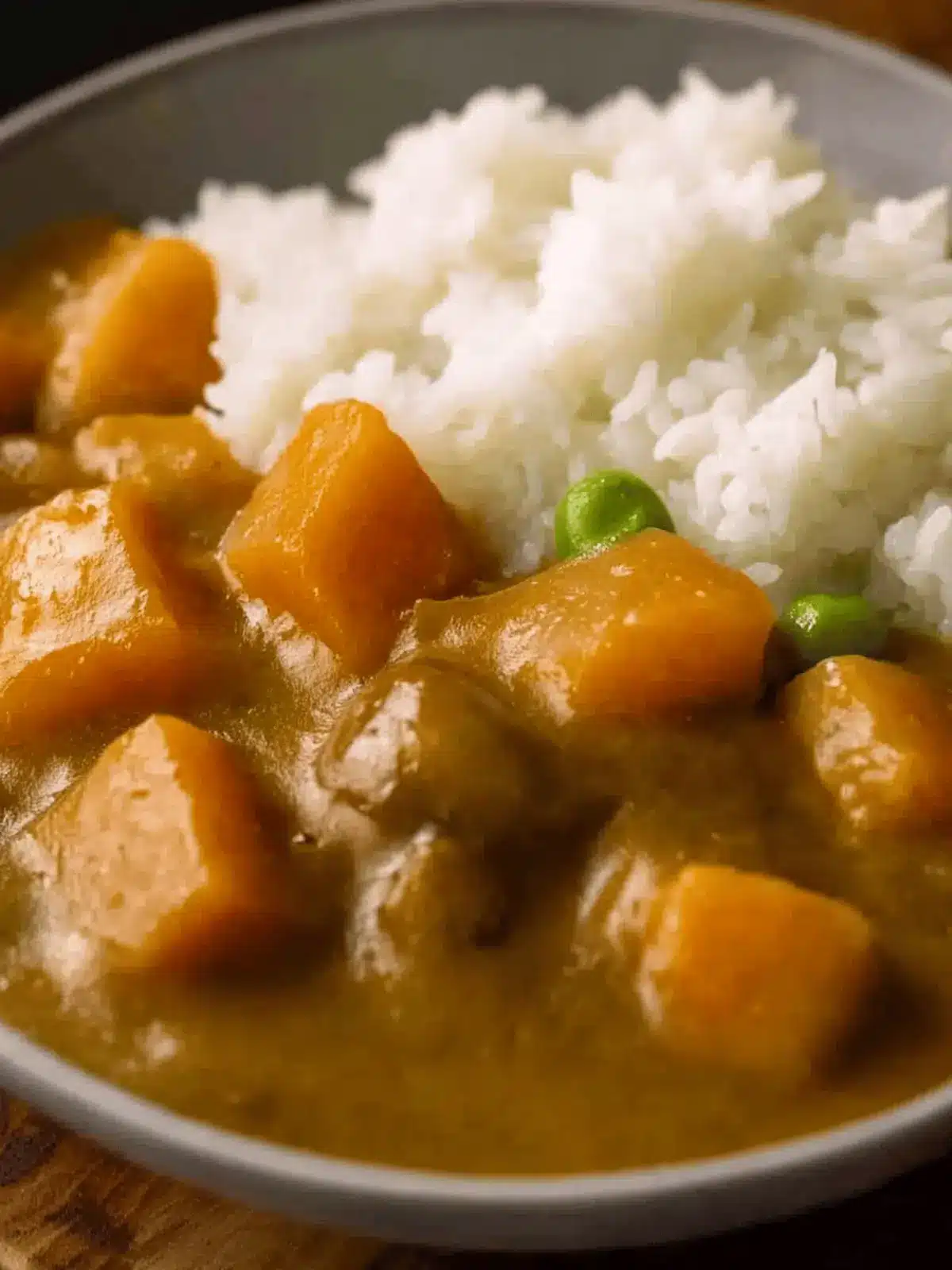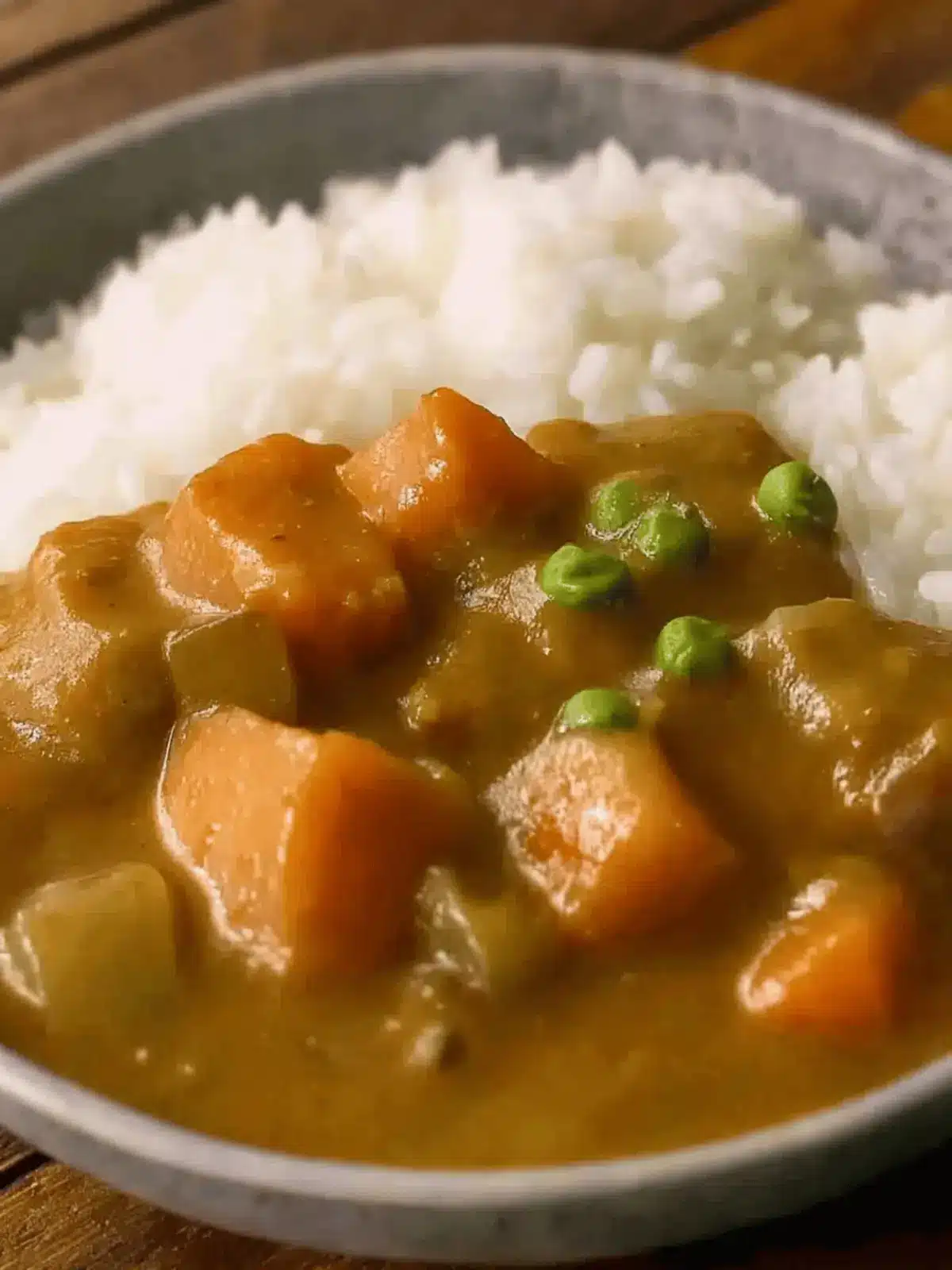When the temperature plummets and leaves begin to fall, there’s nothing quite like the inviting aroma of hearty Japanese curry wafting through the kitchen. This beloved dish, known as Kare Raisu, is a staple in households across Japan, embodying warmth and nostalgia with each comforting bite. Imagine spooning rich, savory curry over a fluffy mound of rice, the tender chunks of beef and vibrant vegetables mingling in a thick, stewy sauce that’s both satisfying and soul-soothing.
What makes this recipe truly special is its simplicity; using just a handful of ingredients, it can easily become your family’s new favorite meal. Whether you’re looking to impress guests or simply cook something cozy for your loved ones, this Japanese curry is a versatile crowd-pleaser that’s perfect for meal prep or busy weeknights. Get ready to enjoy a heartwarming dish that’s as delightful to prepare as it is to savor!
Why is Japanese Curry on Rice so special?
Comforting warmth fills your home as you prepare this delightful dish, making it perfect for chilly evenings.
Family-friendly flavors ensure that kids and adults alike will eagerly dig in.
Versatile ingredients allow for creative substitutions, catering to every palate.
Simple preparation means you don’t need to be a culinary expert to whip it up!
Meal prep magic: this curry is ideal for leftovers, getting better with time and easy to reheat.
Get ready for a hearty meal that brings everyone to the table!
Japanese Curry on Rice Ingredients
For the Curry Base
- Onions – Adds sweetness and depth of flavor; choose large yellow or white onions for the best results.
- Carrots – Provides natural sweetness; parsnips can be a great substitute for a unique twist.
- Potatoes (Yukon Gold) – Acts as a hearty filler, soaking up all that delicious flavor; sweet potatoes work well too!
- Garlic – Enhances the dish’s aromatic depth; always opt for fresh garlic for the best flavor.
- Butter – Adds richness and aids in sautéing the onions; for a dairy-free version, substitute with oil.
- Water or Stock – Forms the curry’s base; using chicken or vegetable stock can really elevate the taste.
- Cubed Beef – Provides a robust protein base; feel free to substitute with chicken, tofu, or lentils if needed.
- Japanese Curry Roux – Delivers that signature flavor and thickness; various brands are available for different spice levels.
For Flavor Enhancers (Optional)
- Worcestershire Sauce – Adds a hit of umami flavor to deepen the taste.
- Ketchup – Brings a touch of sweetness and tang, balancing the savory elements.
- Honey – Enhances the overall sweetness; it’s a great addition if you prefer a sweeter curry.
- Red Apple – Contributes both sweetness and depth; an unexpected yet delightful addition.
Embrace the comforting goodness of Japanese Curry on Rice with these carefully selected ingredients!
How to Make Japanese Curry on Rice
-
Chop: Begin by chopping the onions, carrots, and potatoes into large, bite-sized chunks, ensuring a hearty texture in your curry.
-
Soak: Place the potato chunks in warm water and let them soak for about 15 minutes. This process helps remove excess starch, making them fluffy and perfect for absorbing flavor.
-
Salt: Generously salt the cubed beef and let it rest for a few minutes. This step enhances the flavor and helps tenderize the meat.
-
Sear: In a hot pot, sear the beef in a bit of oil for 2-3 minutes until browned. This builds rich flavor, then remove it and set aside.
-
Sauté: Add butter to the same pot and sauté the onions for 8 minutes, stirring until they become caramelized and golden brown.
-
Add Garlic and Veggies: Incorporate the minced garlic and stir for about 1 minute. Next, add the soaked potatoes and carrots, stirring everything together. Don’t forget to add the beef back into the pot!
-
Pour: Pour in 5 cups of water, mixing in any optional flavor enhancers like Worcestershire sauce or ketchup, and stir to combine.
-
Simmer: Cover the pot and let it simmer for 15 minutes on medium heat. This allows all the flavors to meld beautifully.
-
Check: Use a wooden chopstick to check for potato doneness; they should be tender but not mushy.
-
Dissolve: Gradually add the Japanese curry roux cubes, stirring constantly until the sauce thickens, about 15 minutes on medium-low heat.
-
Serve: Dish out the hot curry over a generous mound of fluffy steamed rice, enjoying the comforting and hearty meal.
Optional: Garnish with pickles or a sprinkle of green onions for added flavor!
Exact quantities are listed in the recipe card below.
How to Store and Freeze Japanese Curry on Rice
Fridge: Store leftover Japanese curry in an airtight container in the fridge for up to 3 days. Reheat it gently on the stovetop or in the microwave, adding a splash of water if needed.
Freezer: Freeze Japanese curry without rice in a freezer-safe container for up to 1 month. Thaw in the refrigerator overnight before reheating on the stovetop for the best texture.
Separation: If you plan to freeze, consider keeping the potatoes separate to maintain their texture, as freezing can make them mushy.
Reheating: Reheat from chilled or thawed state, stirring occasionally, until heated through, ensuring delicious comfort in every bite!
Expert Tips for Japanese Curry on Rice
-
Hot Pot for Searing: Ensure your pot is hot enough before searing the beef; this step locks in flavors and creates a beautiful crust.
-
Thickening the Sauce: If your curry appears too watery, reduce the water you add or utilize a cornstarch slurry to achieve a desired consistency.
-
Selecting Rice: Opt for short-grain Japanese rice like Nishiki or Koshihikari for the perfect texture; it complements the curry beautifully.
-
Meal Prep Advice: This Japanese curry on rice keeps well; store leftovers in the fridge for up to 3 days or freeze portions for a quick meal later.
-
Flavor Adjustments: Feel free to tweak the spice level by using milder or hotter curry roux to suit your family’s preferences or experiment with different vegetables!
Make Ahead Options
These Japanese Curry on Rice preparations are a fantastic way to save time in your busy schedule! You can chop the onions, carrots, and potatoes and store them in the refrigerator for up to 24 hours before cooking. Additionally, the beef can be seasoned and left to marinate in the fridge for extra flavor, also lasting 24 hours. When you’re ready to serve, simply cook everything as instructed, adding an extra splash of water if needed to maintain the desired consistency. This way, you keep the rich flavors intact while making dinner a breeze, ensuring your meal is just as delicious as if freshly prepared!
Japanese Curry on Rice Variations
Customize your dish for an exciting twist that tantalizes the taste buds!
- Dairy-Free: Substitute butter with olive oil or coconut oil for a creamy, non-dairy base. This keeps the curry rich without the dairy.
- Vegetable Boost: Add peas, bell peppers, or zucchini for extra nutrition and a delightful color contrast. They bring freshness and crunch, enhancing the overall experience.
- Heat Level: Use milder or spicier curry roux according to your taste preference. Spice enthusiasts can mix in chili flakes for an added kick!
- Protein Swap: Choose chicken, diced tofu, or lentils instead of beef for tasty variations suitable for different dietary preferences. Each option brings its own flavor and character to the curry.
- Sweet Touch: Incorporate diced sweet apples for a unique sweetness, enhancing the dish while offering an unexpected flavor profile.
- Umami Kick: Mix in a splash of soy sauce or miso for a deeper umami flavor that elevates the entire dish. The savory notes will have everyone asking for seconds.
- Herb Infusion: Stir in fresh herbs like cilantro or green onions right before serving for a fresh burst of flavor. Their vibrant notes will lift the dish to new heights.
- Coconut Cream: Add a can of coconut milk for a richer, creamier sauce that adds tropical vibes to the classic curry. This twist transforms the dish into a comforting delight.
Feel free to mix and match these variations to create a Japanese curry that suits your taste perfectly!
What to Serve with Japanese Curry on Rice?
Creating a satisfying meal is all about harmony, and a hearty Japanese curry pairs delightfully with a variety of sides and accompaniments.
-
Fluffy White Rice: The classic choice that perfectly absorbs the rich curry sauce, enhancing every bite with its comforting texture.
-
Japanese Pickles (Tsukemono): These tangy and crunchy condiments add a burst of flavor, balancing the savory sweetness of the curry.
-
Steamed Broccoli: Bright green and crisp, steamed broccoli offers freshness and a lovely contrast to the hearty curry, making your plate visually appealing.
-
Crispy Tempura: Lightly battered and fried vegetables or shrimp provide a delightful crunch, creating a delightful texture contrast to the creamy curry.
-
Miso Soup: A warm bowl of miso soup adds an umami-rich companion, making your meal feel even more traditional and comforting.
-
Salad with Sesame Dressing: A light salad drizzled with sesame dressing introduces freshness and lightness, perfectly balancing the hearty curry flavors.
-
Green Tea: A soothing cup of green tea complements the meal beautifully, aiding in digestion and enhancing your dining experience.
-
Fruit Salad: A refreshing mix of seasonal fruits can cleanse the palate and bring a sweet note after your savory dish, offering a delightful end to the meal.
Japanese Curry on Rice Recipe FAQs
What type of onions should I use for Japanese curry?
I recommend using large yellow or white onions, as they add a wonderful sweetness and depth of flavor that enhances the overall dish. Avoid using overly pungent onions, which may alter the gentle sweetness that is characteristic of Japanese curry.
How should I store leftover Japanese curry on rice?
Leftover Japanese curry can be stored in an airtight container in the fridge for up to 3 days. When you’re ready to enjoy it again, simply reheat it gently on the stovetop or in the microwave. Adding a splash of water while reheating keeps it velvety smooth and delicious!
Can I freeze Japanese curry on rice?
Absolutely! You can freeze Japanese curry without the rice, placing it in a freezer-safe container for up to 1 month. When it’s time to enjoy, thaw it in the refrigerator overnight. Gently reheat it on the stovetop, stirring occasionally for the best texture. To maintain the integrity of the potatoes, it’s best to freeze the curry separately from the rice.
Advertisement
What should I do if my curry is too watery?
If you find your curry is a bit too watery, you can thicken it in a couple of ways. First, consider reducing the amount of water you initially add to the dish. Alternatively, create a cornstarch slurry by mixing 1 tablespoon of cornstarch with 2 tablespoons of water, and stir it into the curry while it simmers. This helps achieve a thicker, heartier consistency!
Can I substitute the meat in this recipe for a vegetarian option?
Yes, you can easily make Japanese curry vegetarian or vegan! Replace the cubed beef with tofu, lentils, or even chickpeas for protein. Additionally, you can use vegetable stock instead of water for even more flavor. Feel free to toss in your favorite vegetables as well—the more, the merrier!
Is Japanese curry safe for pets to eat?
While some ingredients like cooked potatoes and carrots are generally safe for pets, be cautious with spices and seasonings that may not be suitable. Avoid giving curry to pets due to the various spices, especially garlic, which can be harmful to them. Always check with your veterinarian if in doubt.

Savory Japanese Curry on Rice
Ingredients
Equipment
Method
- Chop the onions, carrots, and potatoes into large, bite-sized chunks.
- Soak the potato chunks in warm water for about 15 minutes.
- Generously salt the cubed beef and let it rest for a few minutes.
- In a hot pot, sear the beef in oil for 2-3 minutes until browned.
- Add butter to the pot and sauté the onions for 8 minutes until caramelized.
- Incorporate the minced garlic for 1 minute, then add the soaked potatoes and carrots.
- Pour in 5 cups of water, mixing in any optional flavor enhancers and stir.
- Cover the pot and let it simmer for 15 minutes on medium heat.
- Check for potato doneness; they should be tender but not mushy.
- Gradually add Japanese curry roux cubes and stir until the sauce thickens.
- Serve the hot curry over steamed rice.








